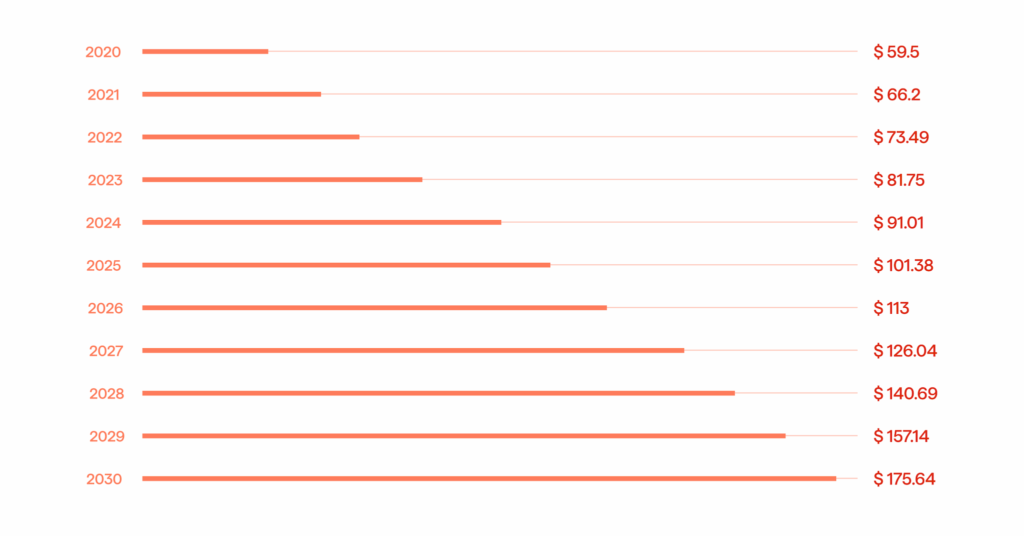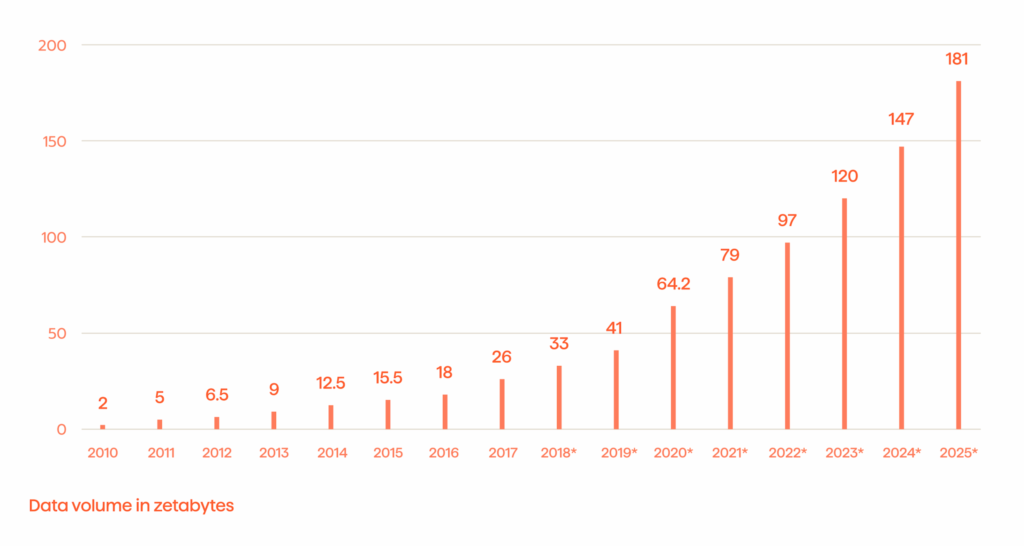Amazon Omics: A New Age of Clinical Research is Rising

April 28, 2025 12 min read
Amazon launched a purpose-built service for bioinformaticians, scientists, and researchers that reinvents the handling of genomic, transcriptomic, and other omics data.
The research domain has always been crucial to the pharmaceutical and life sciences industry. The product fails when the research fails (and most importantly, the company that thinks it hasn’t). In this situation, one of the integral parts of any research process is data processing. Healthcare organizations deal with myriad types of biological and genomic data pursuing the key objective – improve patient care by applying insights from scientific research. These organizations often use comprehensive and complex approaches, such as mapping a patient’s genetic predisposition, profiling various tumours based on how specific genes are expressed within cells, or investigating how microorganisms like bacteria influence health outcomes. Putting these approaches together, you get omics, a new chapter in clinical research.
According to Grand View Research, the global omics-based clinical trials market size is expected to expand with a compound annual growth rate (CAGR) of 7.4% from 2022 to 2030. In addition, the global single-cell multi-omics market is anticipated to reach $8.98 billion in value, which is a major rise from its current value of $1.53 billion. These aspects suggest that the omics-based market is booming. Which is why, major companies like Amazon are investing in the industry and are producing new products like Amazon Omics.
With all the above insights in mind, let’s take a more in-depth look at Amazon Omics in order to understand how pharmaceutical research departments within pharma and biotech companies can deal with the growing demands for transparent, seamless, and systematic data management handling of omics data. In particular, we will explore the connection between omics and precision medicine, by providing several points of significance concerning Amazon Omics, exploring this phenomenon in greater detail, and discovering some of the key Amazon Omics use cases.
The Era of Precision Medicine and Genomic Data Analysis is Here
The rise of digital technologies embedded into healthcare and pharma creates the precondition for innovative approaches to precision medicine that occupies new niches. The world of medicine is approaching the tipping point where highly-personalized and targeted diagnostics will be coming as close as ever before. At this moment, precision medicine is experiencing a major boom that will continue well into the future (see Fig. 1).

In a nutshell, the rise of precision medicine was fueled by such factors as 98% of all medical data is in digital form and a 100,000-fold cost reduction has occurred in genome sequencing since the emergence of the Human Genome Project. Not only DNA, but RNA as well, are sequenced and measured easier than ever before.
One of the key prerequisites for precision medicine market expansion is grounded on the rapid rise in volume of DNA sequencing tests. According to Wired, one sequencing currently costs about $200. This is a major breakthrough considering the cost of DNA sequencing in 2001 was about $100,000,000. Consequently, the introduction of affordable technologies allowed for broader applications. As a result, this phenomenon propagated the biotech industry in general, and precision medicine in particular.
Naturally, exponential growth in data measuring capabilities, along with the digitization of medical information, created the preamble for the omics data explosion. Genomic, transcriptomic, and proteomic data redefine the way researchers understand molecular biology. This in turn, leads to more comprehensive and advanced sequencing analysis, which translates into enhanced drug discovery, identifying genetic predispositions to diseases, vaccine development, and the deliverance of highly-personalized treatments.
Learn more about how we delivered a highly-functional cloud solution that achieves a seamless and automated drug ordering process for QPharma. Success story
As a result, the precision medicine era bloomed. While it is driven by advances in bioinformatics, genomics, and technology, there are a growing number of use cases for the phenomenon. Yet in all this, it is crucial to focus on one particular major advantage – the ability to manage and analyze vast amounts of genomic data. This is at the precise moment when Amazon Omics entered the picture to show us how it is done. With precision medicine becoming more accessible and affordable, omics data management is rising in importance, which is something that needs to be discussed in greater detail.
What Is Amazon Omics and What Is All the Fuss About?
Amazon Omics is a purpose-designed and built service that allows you to store, analyze, and query genomic and biological data at a great scale. Presented by Amazon Web Services (AWS), this tool aims at addressing the rising demand for a cost-efficient and easily scalable solution that enables researchers to manage vast amounts of genomic data generated via advanced sequencing tech. As such, Amazon Omics should help to make sense of the genomic data for advanced scientific research, bioinformatics research, and clinical trials. This could translate into major drug discoveries and personalized medicine strides when done appropriately.
Amazon Omics’ Significance Factors
In order to understand why Amazon Omics is a such big deal, let’s explore its 7 key advantages:
- Fast scalability. The people behind Amazon Omics designed the tool to manage vast scales of genomic and biological data. As a part of the solution, various scaling mechanisms were embedded to help it handle colossal amounts of omics data while also facilitating population-scale analysis.
- Improved security and compliance. Security, privacy, and compliance are a must when dealing with sensitive genomic data. Importantly, Amazon Omics comes with a highly-secured infrastructure and the platform complies with HIPAA and GDPR.
- Higher performance. Amazon Omics leverages the power of AWS’s serverless infrastructure so as to offer high-performance quarrying and analysis capabilities. As a result, researchers equipped with Amazon Omics can make data-driven decisions quickly and analyze genomic data efficiently.
- Cost-effectiveness. Storing large amounts of genomic data is expensive. This represents a huge issue for small organizations and research groups. In turn, Amazon Omics comes with a pay-as-you-go pricing model, which means you do not need to make an upfront investment for storage and computations.
- Easy integration with AWS services. Amazon Omics is integrated with Amazon S3, AWS Batch, and AWS Glue. This means researchers using the tool can build end-to-end bioinformatics workflows with processes like data storage, data processing, and data analysis. Additionally, the AWS ecosystem also grants data visualization capabilities.
- Support for well-recognized bioinformatics instruments. Amazon Omics works hand-in-hand with notable bioinformatics instruments like BWA, GATK, and STAR. Researchers can use both Amazon Omics along with these familiar methods, thus minimizing the overall learning curve.
- Seamless collaboration. Collaboration between researchers is one of the prerequisites for clinical research success. Amazon Omics focuses on such collaboration by making data and findings shareable between research groups. This promotes knowledge exchange, which accelerates the speed of scientific discovery.
The significance factors noted above show that Amazon Omics is a tool worth trying. It was designed to bring researchers closer together, and help them translate vast amounts of genomic data and the outcomes of genomic data analysis into insights that can be broadly applied. In the end, all these lead to more efficient research, faster drug discovery, and highly-personalized medicine.
In-depth Insights Into Amazon Omics
When it comes to understanding how Amazon Omics brings the above listed benefits, we should take a closer look at how this technology functions. This is particularly important in the overall context of the exponential data generation growth across different industries, including healthcare (see Fig.2).

So, returning to the question of Amazon Omics’ functionality, we should explore the following process:
- Omics’ raw sequence data, such as RNA and DNA, being generated.
- This raw data is loaded into Amazon Omics for storage, query, and analysis.
- Amazon Omics uses sequence data storing, which supports large-scale analysis and collaborative research, employs bioinformatics workflows to provision infrastructure and simplify the analysis, and utilizes variant/annotation data to optimize the analysis.
- Amazon Omics outputs analyzed genomic data within multimodal and multi-omic analysis that generates new insights.
While following the process above, we should also highlight that the tool enables translating raw genomic data into intelligible insights because of its structure. Let’s break it down and take a closer look at Amazon Omics’ key components.
Amazon Omics’ Key Components
The tool encompasses three primary components:
- Omics-optimized objects storage
- A managed computer for bioinformatics workflows
- Optimized data stores for population-scale variant analysis
1. Omics-optimized object storage
This part of Amazon Omics enables users to store and share genomic data at a low cost. Designed to manage vast amounts of data generated by genomic research, this component comes with a high-performance storage capability, which is a great fit for large-scale genomics projects.
2. A managed compute for bioinformatics workflows
With this component, users can run specified analyses without the need to worry about any underlying infrastructure provisions. Amazon Omics automates the compute resources management so as to help researchers set the priority on analysis. As a result, users spend less time and effort processing genomic data.
3. Optimized data stores for population-scale variant analysis
This last component offers a unique solution that is designed to handle genomic variant data at a population scale. This means users can efficiently query as well as analyze massive datasets in order to identify different genetic patterns. Subsequently, this component helps in gaining new insights into disease mechanisms, personalized medicine, and drug discovery.
In summary, Amazon Omics works with raw sequenced genomic data and uses the power of its key components to provide researchers with greater storage, analysis, and querying capabilities. As a result, the more valuable data can be handled and better insights obtained. With Amazon Omics functionality in the open, let’s find out how the phenomenon can be used in a practical way.
Amazon Omics Use Cases
Pondering upon vast data volumes, it is often hard to comprehend the scale of data being produced globally. Here is an estimation showing the exponential growth of data volumes in the past decade (see Fig. 3).

Naturally, such a massive influx of data requires increasingly advanced systems and algorithms so as to make sense of the information being generated. Amazon Omics is one such tool that is specifically directed at modern genomics and the biological aspect of the data explosion phenomenon. At this point, let’s delve into how Amazon Omics represents itself practically through the following use cases.
1. Housing And Analyzing Hundreds Of Thousands Worth Of Patient Data
One of the leading examples showing where Amazon Omics can be applied is patient data storage. For instance, healthcare organizations use the tool to securely store, analyze, and manage vast volumes of omics data. Information on hundreds of thousands of patients can be handled simultaneously. In research terms, this means that Amazon Omics users can conduct population-scale analysis. This helps identify underlying patterns and derive valuable insights so as to promote precision medicines that reach better patient outcomes.
With Amazon Omics being used at the population scale, we should also look into public health from a number of unique angles. Analyzed Genomic data can also aid in developing new diagnostic and treatment options that are capable of addressing both individual conditions and diseases that can spread easily. Naturally, tools like Amazon Omics are extremely important in vaccine development, and the recent COVID-19 pandemic stressed the importance of rapid vaccine-building capabilities.
2. Transparent And Replicable Clinical Multi-Omics Workflows For Higher Consistency And Traceability
Another Amazon Omics use case emerges from the fact that the tool offers a robust platform for creating traceable and reproducible clinical multi-omics workflows. Equipped with Amazon Omics, researchers can design as well as execute complex analysis techniques that provide a clear record of the whole process. This ensures consistent results are obtained during the various research stages. As a result, this translates into a more objective and universally applicable finding. By seeing the entire research process through and through, there is a higher chance of obtaining more precise insights.
3. Seamless Multi-Omic Analysis Into Clinical Trials Incorporation
One more use case of Amazon Omics is when researchers use the tool to bring forward multi-omic analysis into the clinical trial process. Because when multi-omic analysis is brought into clinical trials, it improves the understanding of a diseases’ molecular foundation. As a result, researchers can identify potential biomarkers and adapt personalized treatment strategies accordingly.
This is how precision medicine is presented on a large scale. Eventually, as more tools like Amazon Omics are integrated into clinical research, the more healthcare professionals and clinical researchers will be able to come up with treatment solutions based on individual patient profiles.
4. Effective Data Management
This final Amazon Omics use case relates to the effective management of anonymized omics data. The tool comes with elaborate built-in access controls which help ensure that the PHIs are secured while researchers access and analyze the data needed for their studies.
In this use case, built-in access controls secure data access and ensures that the sensitive patient information used in clinical studies remains secure and confidential. It is safe to say, this use case helps researchers avoid data breaches and the potential litigation they might lead to.
The Bottom Line
While Amazon Omics might be considered a supporting tool, its potential for transforming clinical research and precision medicine is immense. Especially, since It helps to address one of the key phenomena that life science faces – rapid data explosion. With the benefits Amazon Omics brings and its elaborate components, there is a greater chance that clinical research, as we know it, will change exponentially. Amazon Omics is one of the bright examples illustrating how technology can redefine the way patient outcomes are enhanced through more advanced clinical trials, drug discovery, and precision medicine.
Even with years of experience in bolstering clinical research with technology, there is always room for adopting new tools like Amazon Omics. Yet, knowing its ins and outs is crucial in order to tap fully into this instrument’s resources.
Contact us to get help with handling omics data and its processes.



